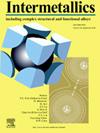On the investigation of the microstructure and mechanical properties of the AlCoCrFeNi2.1/304 heterogeneous gas tungsten arc welded joint
IF 4.3
2区 材料科学
Q2 CHEMISTRY, PHYSICAL
引用次数: 0
Abstract
High entropy alloys have demonstrated significant use potential in the field of petrochemical and nuclear energy equipment. However, the investigation on the heterogeneous joining of the AlCoCrFeNi2.1 and stainless steel is still lacking, and a sound match between strength and ductility is highly pursued. This study aims to perform the welding examination of the AlCoCrFeNi2.1 HEA and commercial 304 stainless steel using the gas tungsten arc approach. A free-imperfection welded joint was obtained, with obvious columnar grains in the FZ. The thermodynamic calculation results, using the obtained results from energy dispersive spectroscopy, revealed that a redundant σ phase emerges in the fusion zone, while the XRD pattern exhibits a phase composition of FCC + BCC in the FZ. This difference is attributed to the rapid cooling rate during the welding process. The average grain size of the FZ near 304 stainless steel and AlCoCrFeNi2.1 HEA is 38.18 μm and 9.90 μm, suggesting a difference in the thermal conductivity of two base metals. The FZ/AlCoCrFeNi2.1 side exhibits obvious brass, cube, S, and α-fiber, with the texture strength being strongest in Brass and Cube, whereas the FZ/304 side displays a much smaller texture strength. The tensile strength of the AlCoCrFeNi2.1/304 welded joints is ∼1022 MPa and ∼27 %, respectively, demonstrating that a great match between strength and ductility is realized. The micro-hardness test results suggested a valley hardness happens in the FZ, within the range of 150∼180 HV0.2, which is consistent with the final fracture zone, indicating a stress concentration occurs in the FZ.
求助全文
约1分钟内获得全文
求助全文
来源期刊

Intermetallics
工程技术-材料科学:综合
CiteScore
7.80
自引率
9.10%
发文量
291
审稿时长
37 days
期刊介绍:
This journal is a platform for publishing innovative research and overviews for advancing our understanding of the structure, property, and functionality of complex metallic alloys, including intermetallics, metallic glasses, and high entropy alloys.
The journal reports the science and engineering of metallic materials in the following aspects:
Theories and experiments which address the relationship between property and structure in all length scales.
Physical modeling and numerical simulations which provide a comprehensive understanding of experimental observations.
Stimulated methodologies to characterize the structure and chemistry of materials that correlate the properties.
Technological applications resulting from the understanding of property-structure relationship in materials.
Novel and cutting-edge results warranting rapid communication.
The journal also publishes special issues on selected topics and overviews by invitation only.
 求助内容:
求助内容: 应助结果提醒方式:
应助结果提醒方式:


